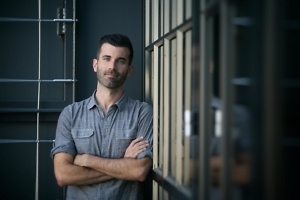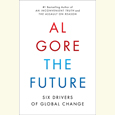A Noble Lunacy
Through the story of a break-in at Oak Ridge, Dan Zak’s Almighty explores the tensions of the atomic age
They were only three people: a house painter, a Vietnam War veteran, and an elderly nun. They carried nothing more dangerous than bolt cutters and hammers. In their backpacks, they had instruments of protest, such as spray paint and banners, and symbols of their faith, including a frayed copy of the New Testament, cucumber seeds, and a loaf of bread topped with a cross.

Before dawn broke on July 28, 2012, they hiked a crest and beheld the Y-12 National Security Complex, the “Fort Knox of Uranium,” in Oak Ridge, Tennessee. With surprising ease, they broke into the facility. They painted graffiti: “Woe to an Empire of Blood.” They tossed human blood upon the walls. With the hammers, they struck off small chunks of concrete, symbolically fulfilling the Bible’s directive to transform swords into plowshares.
In Dan Zak’s Almighty: Courage, Resistance, and Existential Peril in the Nuclear Age, this break-in serves as the departure point for an exploration of the nuclear age. Zak writes of how, since its invention during World War II, atomic weaponry evolved “from a strategy into a policy of faith.” Though Zak is critical of a behemoth nuclear-industrial complex, he captures the ironic resonance of these weapons: “They would remain the pinnacle of human ingenuity and insecurity, a force that binds American power and threatens to blow it apart, a paradox to be pondered and maybe, one day, resolved.”
Zak focuses, especially, on the movement to abolish nuclear weapons, which challenged Americans’ prevalent assumptions about their place in the world. Some activists were scientists, and others were driven by faith. They all “believed that humanity was too frail to tangle with the almighty,” he writes. “The mere possession of nuclear weapons, to them, was a wish for death.” At times, their quest has seemed futile. But Zak admires their principles, even if their demonstrations are driven by a “noble lunacy.”
A reporter for The Washington Post, Zak paints textured portraits of his three protagonists. Sister Megan Rice was eight-two years old when her team broke into Y-12. She grew up in New York City across the hall from Columbia University scientist Selig Hecht, one of the first intellectuals to express concern about atomic power, and cared for her uncle Walter, a Marine who witnessed the aftermath of the nuclear attack at Nagasaki. Inspired by Dorothy Day’s Catholic Worker movement, she found her calling in causes of social justice. She taught in Africa for forty years and then returned to the United States in 2003 to commit herself to anti-nuclear activism. The story of an elderly nun slipping into a massive defense plant was front-page news in The New York Times.
 Rice’s companions shared her spiritual fervor. Michael Walli “was high-strung but gentle, kind but haunted,” Zak writes, “given to rambling prophetic statements about heaven and hell, the devil and Jesus.” After surviving two disillusioning tours in Vietnam, he renounced almost all his earthly possessions and moved into the Dorothy Day Catholic Worker House in Washington, D.C. Through the famed Jesuit pacifist Richard McSorley, he met Greg Boertje-Obed, a soft-spoken housepainter. Boertje-Obed became a central figure in the Plowshares movement of the 1980s, when anti-nuclear protest hit its peak—nearly one million people participated in a Central Park demonstration in 1982.
Rice’s companions shared her spiritual fervor. Michael Walli “was high-strung but gentle, kind but haunted,” Zak writes, “given to rambling prophetic statements about heaven and hell, the devil and Jesus.” After surviving two disillusioning tours in Vietnam, he renounced almost all his earthly possessions and moved into the Dorothy Day Catholic Worker House in Washington, D.C. Through the famed Jesuit pacifist Richard McSorley, he met Greg Boertje-Obed, a soft-spoken housepainter. Boertje-Obed became a central figure in the Plowshares movement of the 1980s, when anti-nuclear protest hit its peak—nearly one million people participated in a Central Park demonstration in 1982.
Zak deftly intertwines the activists’ personal odysseys with the narrative of the larger anti-nuclear movement. As a counterpoint of sorts, he also charts the tragic story of Kirk Garland, the security officer who found them in Y-12. Garland had guarded nuclear facilities for thirty years, and his father and brother both died from health issues related to similar work. The Oak Ridge security breach was rooted in administrative laziness and bureaucratic waste, not in any personal fault. Moreover, Garland calmly handled the intrusion, recognizing that Rice, Walli, and Boertje-Obed posed no danger. Yet Garland was fired. He blamed both the institution and the protestors.
Almighty follows the story into the courtroom, where the trial of the three activists served as a forum for bigger questions about peace and justice. Besides arguing that these protestors meant no real harm, the defendants’ lawyers framed the case in moral terms. But the jury sided with the prosecution, which could point to an obvious crime that compromised national security. An appeals court later overturned their conviction on sabotage, and the three were released, based on time already served.
The book’s final chapters bound around the globe. Zak chronicles a fifty-six-mile peace walk through the desert, from Las Vegas to a nuclear test site. He travels to the Marshall Islands, a Pacific island chain still confronting the devastating legacy of Cold War bomb tests. He journeys to the Vienna Conference on the Humanitarian Impact of Nuclear Weapons, where representatives of the United States fended off criticisms from the Humanitarian Initiative, an international coalition seeking to outlaw nuclear weapons. The American government can be a force for change, as indicated by President Obama’s early calls for a nuclear-free world. But in today’s complicated geo-political environment, it is practically impossible to verify compliance. So the status quo holds. The production of nuclear weapons intensifies.
Zak provides no easy answers. But he appreciates the sacrifice of people like Megan Rice, Michael Walli, and Greg Beortje-Obed. Yes, they were driven by an unsettling, righteous fervor. And yes, they broke the law. But the abolitionists were also once self-righteous radicals. So were those who fought for women’s suffrage. Civil-rights activists constantly broke the law. They sought a higher freedom, beyond the bounds of the world in which they were living, and their real judge is history.

Aram Goudsouzian chairs the history department at the University of Memphis. His most recent book is Down to the Crossroads: Civil Rights, Black Power, and the Meredith March Against Fear.


